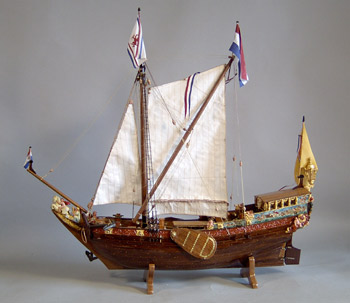Started Sailing
Need for speed and violence led to elegance: the Dutch Yacht and the Pinnace.
by Han
(Brittany, France)

Dutch Yaght 17th century.
Several factors incited the Dutch at the end of the 15th. century to develop small, shallow-draught, fast, seaworthy and easily manoeuvrable, close-to-the-wind sailing ships: the abundance of shallow waters around the coast and the possession of a big fleet of deep-draught merchantmen which often had to anchor far from the coast; the need for messengers between the ships of a fleet, and scouting tasks.
They were built as improvements of existing fishing boats and inland waterway-vessels, with side-boards and rigged fore-and-aft: one mast with a quadrangle spritsail as main, and a triangular staysail in front, often supplemented with a jib rigged to the removable jib-boom. They were called yaghts, the Dutch word for "fast running". In the picture you see the model of the yaght built for a Dutch prince; later one was built as a present to the English king, who went racing with it; thence the English word "yachting" for the sport. See also:
http://www.wordcentral.com/cgi-bin/student?yacht.
The Dutch used to race them too: see the beautiful painting on http://www.nmm.ac.uk/visit/exhibitions/past/turmoil-and-tranquillity/gallery/?item=12 and and use the zoom-function to see the details!
Later the spritsail was replaced with a gaffsail because that had better aerodynamical qualities and was easier to handle. This rig was the fore-runner of the Bermuda rig.
Bigger versions of this modern yacht, with additional square sails, were often used as privateers, see: ttp://en.wikipedia.org/wiki/Privateer, and evolved to the Pinnace in the beginning of the 17th. century, see:
http://en.wikipedia.org/wiki/Pinnace.
Click here to post comments
Return to Han Blog.
|
|

